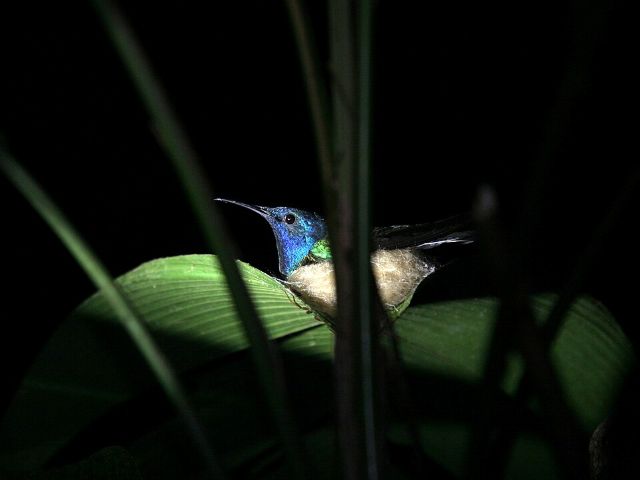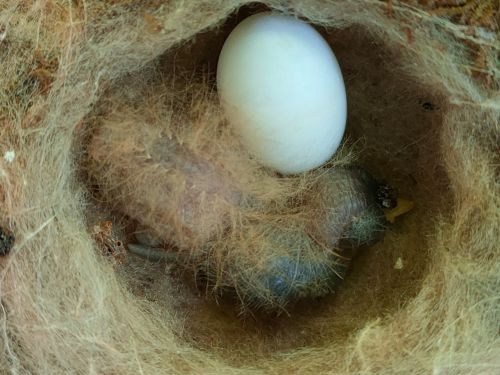Young white-necked jacobin defends itself with appearance and behaviour
A young white-necked jacobin looks like a caterpillar with urticating hairs and behaves like one. It is to deter its predators, Jay Falk and colleagues hypothesize.
A newly hatched white-necked jacobin hummingbird looks little like a young bird at first glance. It is a hairy creature that lifts its head and shakes it from side to side as soon as something approaches. Only when its mother announces her arrival with a special signal does it behave normally: it opens its mouth wide to beg for food.
The white-necked jacobin, Florisuga mellivora, lives in the Amazon region. The mother builds a nest and takes care of it on her own, as in other hummingbird species. She lays one or two eggs and incubates them. The young hatch after about two weeks and fledge a few days later.
Jay Falk and colleagues suggest that a chick’s peculiar appearance and behaviour are a response to its vulnerable position. It lies in a cup-shaped nest that is exposed on a plant leaf. The mother regularly flies away to eat, leaving the young in plain sight and unattended.
Deterrent
A white-necked jacobin chick first tries not to stand out. Its ‘hairs’ are exceptionally long natal down feathers that grow on its back. They are the same colour as the seed fluff that lines the nest, camouflaging the young bird well. Also, it may be a physical barrier that prevent small predators from reaching its body.
When predators discover and approach the creature despite its camouflage, it has another trick: mimicry. Due to its hairy appearance and the way it shakes its head, the young bird looks like a caterpillar with urticating hairs. There are several types of caterpillars with irritating stinging hairs in the area, and predators prefer to leave them alone.
The extent to which white-necked jacobin chicks benefit from this fear response and deter predators through their imitation needs further investigation. It seems to work, because the researchers saw how a carnivorous wasp that can overpower young birds approached a white-necked jacobin nest. The wasp inspected the nest but made off when the young started playing caterpillar.
Other caterpillar mimics
The behaviour and the long down feathers of white-necked jacobin chicks are unusual. The only other hummingbird species with young that have such feathers is the black hummingbird, Florisuga fusca. This related species also makes an open, cup-shaped nest on a plant leaf, and its young also appear to imitate a caterpillar.
Strange as it may be, these two hummingbird species are not the only birds with young that resemble caterpillars. The same phenomenon has been extensively described for the South American cinereous mourner (Laniocera hypopyrra), whose orange, hairy young mimic a poisonous caterpillar species. The shrike-like cotinga (Laniisoma elegans) also has young that resemble a hairy caterpillar.
Willy van Strien
Photos
Large: white-necked jacobin (male-like female) on nest. Caspar S (Wikimedia Commons, Creative Commons CC BY 2.0)
Small: nest with young and egg. © Michael Castaño-Diaz
More about white-necked jacobin: crossdressing
Sources:
Falk, J.J., M. Castaño-Diaz, S. Gallan-Giraldo, J. See & S. Taylor, 2025. Potential caterpillar mimicry in a tropical hummingbird. Ecology: 106: e70060. Doi: 10.1002/ecy.70060
Londoño, G.A., D.A. García & M.A. Sánchez Martínez, 2015. Morphological and behavioral evidence of Batesian mimicry in nestlings of a lowland Amazonian bird. The American Naturalist 185: 135-141. Doi: 10.1086/679106
D’Horta, F.M., G.M. Kirwan & D. Buzzetti, 2012. Gaudy juvenile plumages of cinereous mourner (Laniocera hypopyrra) and Brazilian Laniisoma (Laniisoma elegans). The Wilson Journal of Ornithology 124: 429-435. Doi: 10.1676/11-213.1

